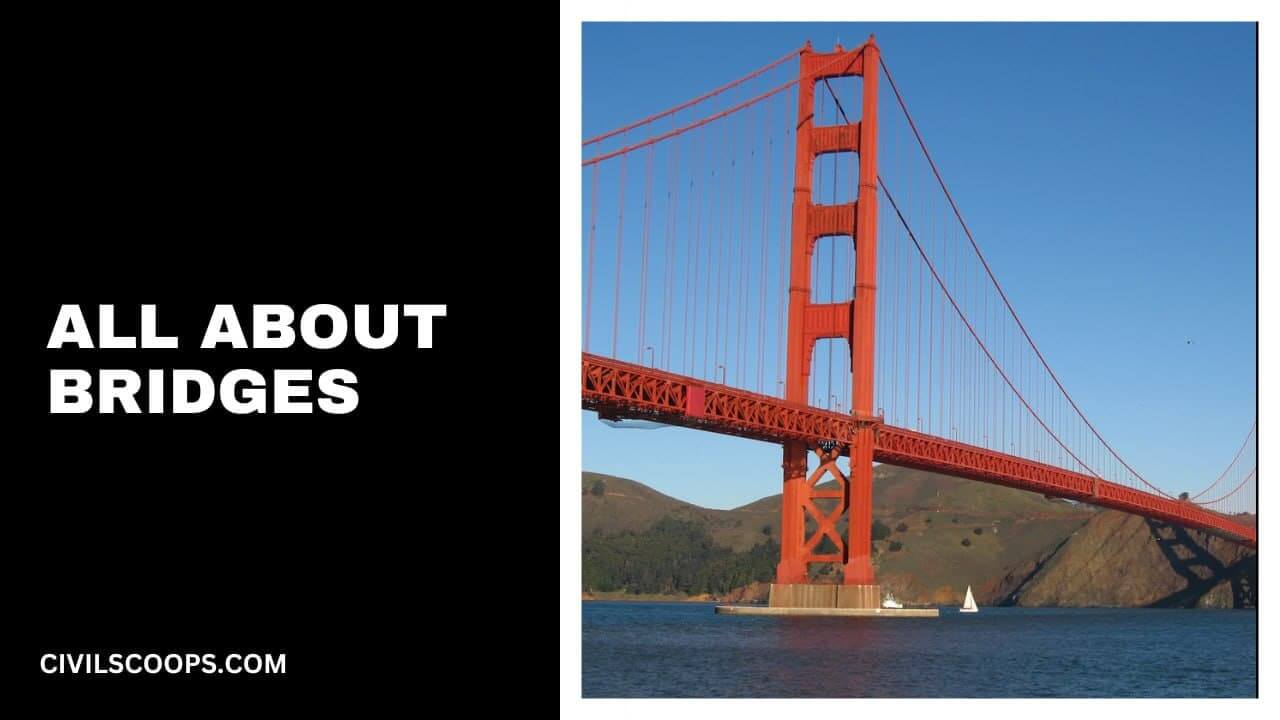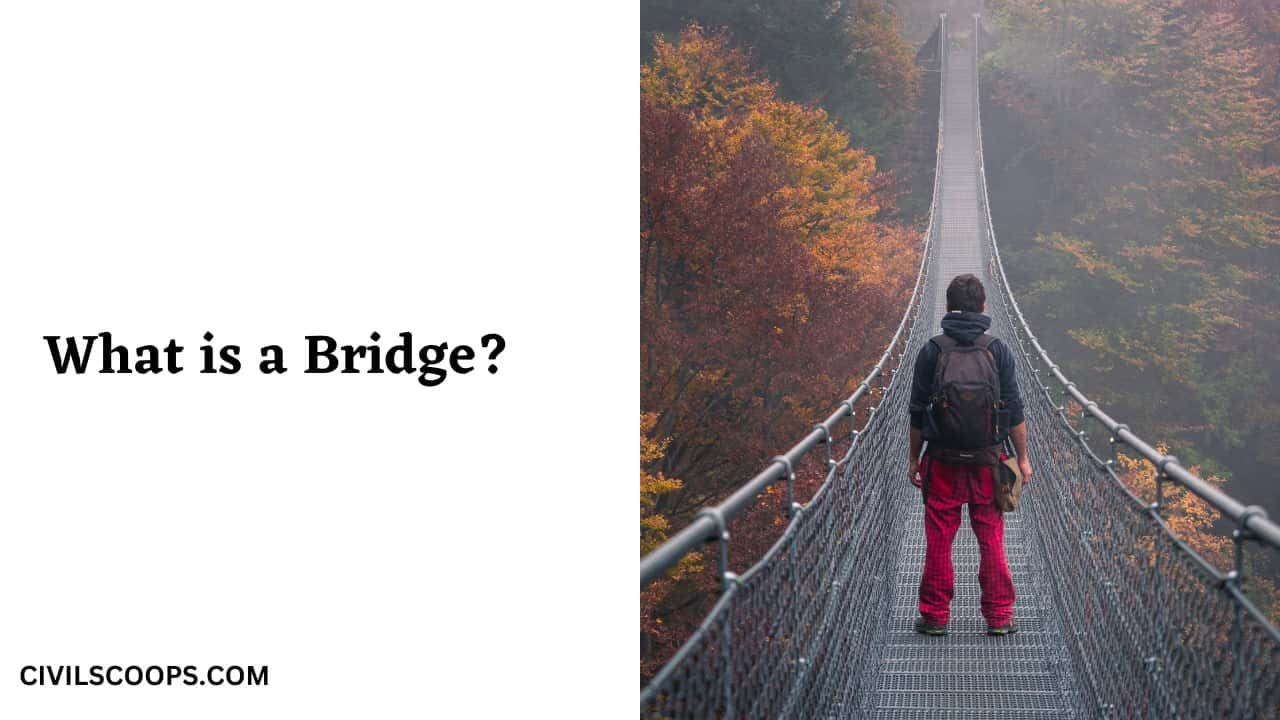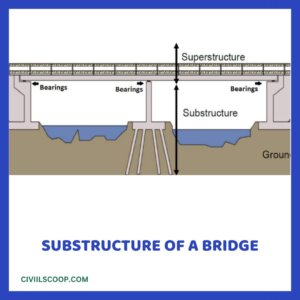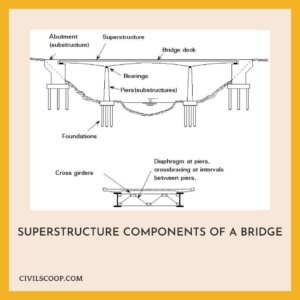What Is Bridge | Components of Bridge and Their Function

Table of Contents
What Is Bridge?

A bridge is a system for transporting road traffic and perhaps other moving loads across a deep gorge or obstacle, including a river, a canal, a road, or a railroad.
Throughout ancient times, the first bridges are built across small streams only with aid of trees down or togs of wood. Subsequently, the Style Bridge suspension was formed by twisted creepers connected to the tree branches from either side of the gorge.
Starting with rope as well as chain footbridges, engineering has evolved rigorously and thoroughly and is among the great accomplishments of the engineering genius of humankind.
Also Read: Difference Between Flyover and Bridge | What Is Flyover | What Is Bridge
Components of Bridge and Their Function

The main components of the bridge are :
- Substructure.
- Superstructure.
- Adjoining Structure.
1. Substructure Components of Bridge

The components of the bridge involved in the substructure of bridges are:
- Piers.
- Pier cap.
- Abutments.
- Wing Walls and the Returns.
- Foundation.
- Pile.
- Pile caps.
- Bents.
1. Piers
The piers are vertical framework components of the bridge that are used to stabilize the deck or even the bearings required for the movement of the load to the underground soil via the foundation. Such systems act as reinforcement for bridge spans at intermediate stages.
The pier structure has two major objectives:
- Move loads to the Foundation.
- Resistance to the lateral forces.
Any of the piers are designed to withstand vertical loads on their own. In locations inside the earthquake environment, it is suggested that the pier be built for lateral loads as well.
Several of the piers are made of concrete. Steel for the building of the pier has been used in so few instances so far. Through the use of composite columns, hence steel columns packed with concrete are seen as a modern pier building technology.
The pier is a vertical member which absorbs forces by way of a shear mechanism. These forces are predominantly lateral forces. The pier consisting of several columns is labeled bent.
Types of Piers in Bridge Construction:
There seem to be various types of piers based on structural connection, segment form, and frame layout.
- The pier could be graded as monolithic as well as cantilevered on the basis of structural connectivity.
- Dependent on the form of the segment pier, it may be categorized as solid or hollow, hexagonal, circular or octagonal, or rectangular.
- Based on the frame design, the pier may be categorized as a single or multiple-column bent, a hammerhead, or a pier wall type.
2. Pier Caps
Pier caps are one of the components of bridges often classified as headstocks. This serves as space for girders to pass loads on bearings (which split the load between all piers) from either the superstructure components of a bridge on the top.
3. Abutments
Abutments are components of bridge vertical structures that are used to keep the soil behind the building. The dead as well as the live loads of the bridge superstructure are assisted by the bridge abutments.
The abutments are often exposed to lateral stresses, primarily from the approach bank. The geometry loads on the abutment are based primarily on:
- The type of abutment you chose.
- Construction series.
- The abutments are primarily designed to survive overturning and slipping. More emphasis is on the reliability of the whole system.
Care needs to be taken to the foundations of the abutments. The base of the abutment must solve the problems of differential settling and unnecessary motions induced by lateral forces or loads.
Also Read: All About Pier and Pile | Difference Between Pier and Pile | What Is Pier | What Is Pile
4. Wing Walls and Returns
Structures built as an extension of the abutments to hold the earth current in the access bank are termed wing walls. Anything else, the such a section would have a normal angle of rest. There are retaining walls built parallel to the buttresses. This wall may be designed either completely or independently from the base wall.
Three design loads can be considered at the rear of the wall when building. This contains the following:
- The Earth Pressure of the Backfill
- A surcharge from a live load or a compacting plant
- Hydraulic loads due to saturated soil conditions
The stability of the wing wall is primarily dependent on its resistance to active earth pressures. The structural components of bridges are built and constructed to survive the stresses of the earth at rest.
5. Foundation of Bridges
The foundations are structures designed to transmit loads from piers, buttresses, wing walls as well as returns uniformly to strata.
The foundation established for bridge structures is deep enough to prevent scouring due to the flow of water or to limit the chances of weakening it.
6. Pile
Piles are generally placed to support the bridge as well as build up the initial base. The piles allow the weight and tension of the bridge to be spread uniformly through the earth, making it secure and solid.
Material and battery configuration rely on a variety of variables, such as soil condition, soil volatility, and load-bearing capacity limit. In the case of river bridges, scouring is often required even before the bridge is constructed.
7. Pile Caps
Pile Caps include extra load transfer power to the stacks. These also are recognized as pile caps, since they are put right at the top of the pile base. Caps are also constructed of very strong concrete to provide optimum protection to the roof of the bridge.
8. Bents
As the stacks and caps are placed together, they are named bents. Multiple bents form the base for the substructure.
2. Superstructure Components of Bridge

The bridge construction superstructure components of the bridge consist of
- Girders
- Trusses
- Barrier
- Arches
- Decks
- Bearings in Bridges
- Parapets and Handrails/ Guard Rails or Curbs
These components of a bridge differ depending on the bridge design (whether concrete or steel or composite). The bridge superstructure carries the load going over. It also helps to transfer the forces generated by the loads to the substructures beneath.
1. Girders
Girders are also components of a bridge that joins together both of the pile caps by expanding across them. Girders are often related to beams that provide protection to the deck.
There may be a single span, or perhaps even multiple spans linking all the bents, depending on the length of the bridge.
Girders typically also have truss configuration to enhance stress as well as load resistance. Pressure is then easily transferred to the base. Girders are often made of aluminum or concrete.
2. Trusses
Trusses are components of a bridge rendered by combining the triangular elements to separate the loads as well as bend the moments across the bridge. Other types are plain trusses, suspension, and cantilever trusses.
The truss network includes a distribution surface that can be designed as a deck truss, a pony truss, or a truss. Every other truss varies in the way the traffic travels on the bridge.
3. Barriers
Components of the bridge that is barriers are Primarily safety and security elements, bridges have walls on the sides of their decks. They may be custom-built fixtures, chains, rails, barriers, or concrete walls for improved aesthetics.
4. Arches
The bridge with the arches does have a great deal of momentum. Arches may help monitor the stability and load-bearing strength of the bridge. The amount of arches as well as materials used during building is very significant.
The area between the bridge pillars as well as the deck beam is named the spandrel. Depending on the configuration of the arch, spandrels may be extended or closed.
5. Decks
The deck is a component of the bridge known to be the road or rail surface of the bridge. The decks are protected by the girders or the massive beams which are protected by the piers. The entire structure is backed by a deep foundation, primarily piles as well as cap arrangement.
6. Bearings in Bridges
The loads obtained by the decks are conveyed correctly and securely to the substructure only with aid of the bearings. All those are components of the bridge that allow even the distribution of the load mostly on substructure components of bridge material.
Such transmission is particularly critical in conditions in which the substructure also isn’t built to take some action on the load. The bearings in the bridges enable the longitudinal movement of the girders.
Such movement is generated by the loads exerted in the longitudinal direction. The forces due to shifting loads as well as temperature variation are the major sources of longitudinal forces.
The choice of bearings depends on certain factors, such as acting weights, geometry, degree of upkeep, clearance required, displacement, rotation and deflection policy, affordability, manufacturer preference, construction tolerances, and cost requirements.
For the construction of the bridge, all of the considerations or components of the bridge listed above are considered for the design and choice of bearings. The builder must regard the bearing structure of the bridge construction as a separate device.
In certain building activities, the bearing is chosen or the bearing decision is taken at the last minute. Such a result in a rise in maintenance in the future, which must be stopped.
7. Parapets and Handrails/ Guard Rails or Curbs
Such components of the bridge would not be of structural significance, they are given for safety considerations. They are given above the decks. This would help keep the car from sliding off the bridge onto the water body below or as a way of separating the traffic streams.
3. Adjoining Structures
It involves the followings components:
- Guard stones.
- Approaches.
1. Guard Stones
They are utilized to limit transportation on a specific lane or occasionally as road railing but are usually located to defend an exact thing, such as a corner of a street or the side of a gate.
2. Approaches
It is organized built at the preliminary or ending of any bridge. Its chief purpose is to deliver smooth and easy entrance or leaving from a bridge.
[su_box title=”FAQ” style=”default” box_color=”#333333″ title_color=”#FFFFFF” radius=”3″ class=”” id=””]
Components of Bridge
Components Of Bridge
- Deck.
- Superstructure.
- Substructure.
- Foundation.
- Girder or beam.
- Bridge tower.
- Pier.
- Pier cap.
Superstructure of a Bridge
Superstructures are defined by AASHTO as “Structural parts of the bridge that provide the horizontal span.” This is a very general definition. For conventional bridges, the superstructure is often defined as the portion of the bridge above the bridge bearings.
What Are the Components of a Bridge?
The main components of a bridge are the foundation, substructure, and superstructure. Each of these core areas have other parts within them. Piles and pile caps are constructed as the foundation of the bridge.
Parts of a Truss Bridge
In a truss bridge, two long – usually straight members known as chords – form the top and bottom; they are connected by a web of vertical posts and diagonals. The bridge is supported at the ends by abutments and sometimes in the middle by piers.
What Is a Truss Bridge?
A truss bridge is a bridge whose load-bearing superstructure is composed of a truss, a structure of connected elements, usually forming triangular units. The connected elements may be stressed from tension, compression, or sometimes both in response to dynamic loads.
What Makes a Truss Bridge Strong?
The bridge is supported at the ends by abutments and sometimes in the middle by piers. A properly designed and built truss will distribute stresses throughout its structure, allowing the bridge to safely support its own weight, the weight of vehicles crossing it, and wind loads.
What Does a Truss Bridge Look Like?
The beams are usually arranged in a repeated triangular pattern since a triangle cannot be distorted by stress. In a truss bridge, two long – usually straight members known as chords – form the top and bottom; they are connected by a web of vertical posts and diagonals.
What Truss Bridge Is the Strongest?
Of the three bridge designs I tested (warren-truss, pratt-truss, k-truss) the warren-truss held the most weight. I tested each design 5 times and the average for the warren was 43.6 pounds. The k average was 31 pounds and the pratt design was the weakest and averaged 13.6 pounds.
What Are the Different Types of Truss Bridges?
There are numerous wood and metal truss types. The wooden Bunker Hill Bridge is a Haupt truss, a type invented in 1839. There are many types or subtypes of metal truss bridges, but only five were common in North Carolina — the Pratt, the Warren, the Parker, the Camelback and the Pennsylvania.
What Are the Different Types of Bridges?
There are six basic bridge forms: the beam, the truss, the arch, the suspension, the cantilever, and the cable-stay.
What Are the 3 Main Types of Bridges?
Three basic types of bridges used in transportation are: beam and truss bridges, arch bridges and suspension bridges.
What Are Bridges Made of?
Some of the main materials found on a bridge are steel, concrete, stone and asphalt. Other materials include iron, timber, aluminum, rubber and other joint materials. Below is a description of some typical uses for these materials in a bridge.
What Are Bridges Used for?
The purpose of a bridge is to allow people or cargo easy passage over an obstacle by providing a route that would otherwise be uneven or impossible.
What Are Beam Bridges Made of?
The simplest beam bridge could be a log (see log bridge), a wood plank, or a stone slab (see clapper bridge) laid across a stream. Bridges designed for modern infrastructure will usually be constructed of steel or reinforced concrete, or a combination of both.
What Are Cable Stayed Bridges Made of?
The early suspension-bridge towers were stone, but now they are either steel or concrete. Next, the anchorages are built on both ends, usually of reinforced concrete with embedded steel eyebars to which the cables will be fastened.
Substructure Components of Bridge
The substructure of a bridge is the component that supports the superstructure and distributes the load to the bridge footings and foundation. They consist of piers, abutments, wing walls all of which facilitate the process of transmitting the weight of the load to the earth.
What Bridge Is the Strongest?
Advantages of Truss Bridges
The strongest type of bridge.
Pier Cap in Bridge
“Pier caps transfer the loads from the superstructure to the piers. They hold the bridge girders on bearing pads and disperse the loads from the bearings to the piers. Bridges with piers will all have pier caps to transfer the load from the superstructure.
What Is Abutment in Bridge Construction?
Abutments are used at the ends of bridges to retain the embankment and to carry the vertical and horizontal loads from the superstructure to the foundation.
What Is Wing Wall in Bridge?
A wing wall is a structural member located at the end of a bridge structure. When it is constructed integrally with the abutment, it is termed as cantilever wing wall and when separated from the abutment with expansion or construction joint, it is called an independent wing wall.
What Are the Disadvantages of a Cantilever Bridge?
Although cantilever bridges typically last for years, there is a higher chance of failure when bridges are not attached to the sturdier teeth found at the back of the mouth. Damage may occur. Because they are only anchored on one side, there is a slightly higher risk of cracking or debonding than with other bridges.
How Are Foundations of Bridges Built?
The most common way to construct a deep foundation for a bridge is called piling. Long, narrow posts called piles are hoisted into the air by a crane and driven into the ground by a large hammer called a piledriver (not that piledriver). After the pile reaches the required depth, it is capped off and tied.
What Is Parapet in Bridge?
A bridge parapet is a barrier along the edge of a bridge designed to prevent road users from falling or driving off the side of the bridge. A parapet may also restrict the the ease of throwing objects over the side of the bridge and/or act as a noise barrier.
How Is the Foundation of a Bridge Built?
The most common way to construct a deep foundation for a bridge is called piling. Long, narrow posts called piles are hoisted into the air by a crane and driven into the ground by a large hammer called a piledriver (not that piledriver). After the pile reaches the required depth, it is capped off and tied.
Materials Used to Build an Arch Bridge
Arch bridges are built using stones, bricks, wood, concrete, and steel. To construct an arch bridge, a falsework must be put into position first. A falsework is a temporary structure, generally built from wood, that’s used to hold the bridge together as it is being constructed.
Bearings in Bridges
Bearings are the devices that transfer the traffic loading and the weight of the bridge from the superstructure to the substructure. Bearings also allow the bridge to expand and contract, as well as allowing for rotation of the beams as they deflect under live loads.
What Does Bridge?
: a structure carrying a pathway or roadway over a depression or obstacle (such as a river) a bridge connecting the island to the mainland. : a time, place, or means of connection or transition. building a bridge between the two cultures. the bridge from war to peace.
How Does a Suspension Bridge Work?
Suspension bridges get their name from the fact that the roadway is suspended by cables from two tall towers. Most of the weight is supported by the two towers. They, in turn, pass the compression forces from the cables directly into the ground. Suspension bridges also have smaller cables called suspenders.
How Does a Cable-Stayed Bridge Work?
In suspension bridges, the cables ride freely across the towers, transmitting the load to the anchorages at either end. In cable-stayed bridges, the cables are attached to the towers, which alone bear the load. The cables can be attached to the roadway in a variety of ways.
How Does a Cantilever Bridge Work?
Cantilever Bridge. —A structure at least one portion of which acts as an anchorage for sustaining another portion which extends beyond the supporting pier. A simple cantilever span is formed by two cantilever arms extending from opposite sides of an obstacle to be crossed, meeting at the center.
Bridge Construction Methods
Bridges Should Be Built Using Repetitive Prefabricated Elements
- Precast deck panels and girder systems.
- Precast pier systems.
- Precast modular abutment systems.
- Modular superstructure systems.
- Bridge erection systems.
What Is a Bridge Load?
Bridge load rating is the measure of a bridge’s ability to carry a given live load expressed by a simple factor called the Rating Factor (RF), or referred to as Tonnage for Legal and Permit load rating. Basically, this is the assessment of bridges in their current condition to carry live loads.
What Is a Dead Load on a Bridge?
Dead load The weight of the permanent, nonmoveable parts of a structure, such as the towers, cables, and roadway of a bridge. Live load The weight of a structure’s nonpermanent, moveable parts, contents, or “users,” such as the traffic, people, and seagulls on a bridge.
[/su_box]
[su_note note_color=”#F2F2F2 ” text_color=”#333333″ radius=”3″ class=”” id=””]
Like this post? Share it with your friends!
Suggested Read –
- All About Sand | What Is Sand | 29 Types of Sand | Composition of Sand
- 19 Different Types of Slabs in Construction | What Is a Slab | Types of Slabs
- All About Gypsum Plaster | What Is Gypsum Plaster | 15 Advantage of Gypsum Plaster | Disadvantage of Gypsum Plaster
- All About M Sand | What Is M Sand | Properties of Manufactured Sand | Advantages & Disadvantages of Manufactured Sand
- All About Uscs | Which Test Gives a Better Estimation of the Friction Angle | Introduction of USCS ( Unified Soil Classification System )
[/su_note]
Originally posted 2023-01-30 09:56:30.
